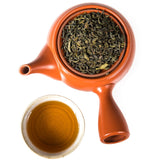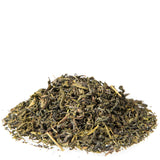DUE TO HIGH DEMAND, THIS TEA IS SOLD OUT
– Sensei, my mind is stuck. I need a refreshment. I will go out to smell the flowers and feel the caress of the green grass in our garden.
– Dear boy, the flowers' sweet aroma and the green grass' freshness are all inside this tiny cup of tea. Have a sip and invigorate your mind.
A truly exotic tea, "Kagutsuchi" Suruga-wase Japanese Oolong tea is Path of Cha's proud addition to our Oolong tea collection.
This Japanese Oolong comes from an organic tea plantation in Isagawa, West Shizuoka. The plantation stretches at 350-500m above sea level in an area known as "the organic valley". It enjoys shading from the surrounding mountain ridges and a naturally occurring mist that fills the air with moisture. Right next to the tea gardens is a river with pure, drinkable water that runs downstream to the lower mountain.
The tea producers of Suruga-wase Japanese Oolong pair the exceptional ecological surroundings of the area with the local tea masters' organic cultivation know-how. The result is purely organic tea, without the use of any pesticides or fertilizers.
Suruga-wase Japanese Oolong is a lightly oxidized tea. It has a sweet, floral mouthfeel with tender notes of lemongrass. Its production process recalls the traditional Taiwanese Baozhong Oolong. The picking season for this tea starts in later June. Tea farmers process the leaves the very same day. First, they spread them in the sun to wither under close temperature supervision and constant turning. Once the leaves start to wrinkle and lose their luster, farmers put them indoors for the next phase of withering. They then proceed to "bruising" – a crucial processing stage for Oolong tea. It involves shaking and resting the tea leaves for a couple of hours. This stage defines the degree of oxidation for the tea leaves and greatly impacts the aroma and taste profile of the finished tea.
After that, processing moves on to the "fixing" stage. Farmers put the leaves in heated pans and stir-fry them until loud popping sounds appear. They then immediately transfer the leaves for a 10 min rolling phase. This stage fixes the tea leaves' shape and ensures a proper infusion once the leaves are brewed in hot water. After that, farmers will break any lumps that may have formed during the rolling phase. Finally, the leaves dry at 100ºC for about half an hour. That ensures the removal of any enzyme activity that survived the fixing stage. It also eliminates the raw grassy smell, improves the aroma, and lowers the moisture for optimal storage.
In the best traditions of Taiwanese Baozhong processing, our "Kagutsuchi" Suruga-wase Japanese Oolong processing doesn't imply roasting. That accounts for a mild taste with subtle grassy astringency. Indeed, this Oolong stands out for its well-balanced bitterness and mild astringency, which nicely counterpart its sweetness. One can say that "Kagu-tsuchi" is a crossover between oolong and green tea.
Brewing guidelines:
![]() 205℉ / 95℃
205℉ / 95℃
![]() 1g per 60ml
1g per 60ml
![]() 1min for the first infusion; +30sec for each subsequent infusion
1min for the first infusion; +30sec for each subsequent infusion
 1g per 30ml
1g per 30ml 


